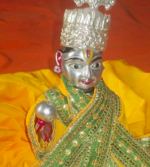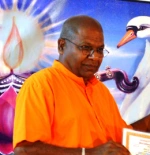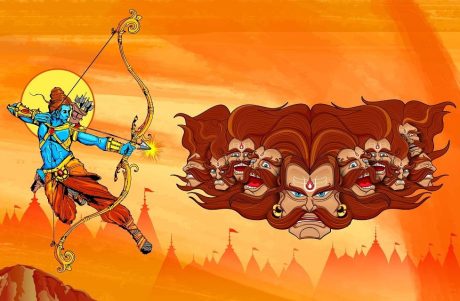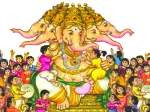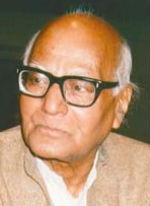 The rebuilding of the Ram Temple in Ayodhya physically signals the redemption of the human evolutionary process that had come to stagnate with the advent of the Abrahamic faiths. This event assumes great spiritual significance and calls for collective introspection. It signals a radical change in the thought process of the species. – George Thundiparambil
The rebuilding of the Ram Temple in Ayodhya physically signals the redemption of the human evolutionary process that had come to stagnate with the advent of the Abrahamic faiths. This event assumes great spiritual significance and calls for collective introspection. It signals a radical change in the thought process of the species. – George Thundiparambil
Ever since Abram and Sarai set foot in the Promised Land and subsequently changed their names to Abraham and Sarah, the concept of spirituality assumed a course of aggression that culminated in the physical destruction of many ancient cultures that had gone before them.
History and myth intersected with the advent of Judaism and Christianity and the symbolic subjugation of Canaan and its idol-worshipping polytheists became concretely entrenched in the real historical trajectory of Abraham’s spiritual descendants—the Christians and the Muslims.
Whereas Abraham’s exploits are pure myth and confined to the book, these two derivative faiths ploughed a path of destruction of ancient pagan temples and the forcible conversion of cultures all over the earth. A terrible campaign of genocide was unleashed to an extent hitherto unknown to the human species.
Almost every important church and mosque that exists today on earth has been built on the sacred cultural site of a vanquished people that lies buried with their gods and goddesses, known and unknown.
What looked like an unstoppable monotheistic train to many for nearly 2,000 years now looks spent as a spiritual force and the rationale that justified their actions now seems spurious and fake in the light of reason and the collective experience of the species.
But the charade goes on as if human intellect, rationality and experience are merely a negotiable matter and that they are on a par with superstitions and unsubstantiated a priori assumptions.
In this background, 5th August 2020 is a watershed in spiritual and cultural history. It signals a reversal of the current spiritual trend, and that fact is going to be etched in stone.
A very important pagan temple is rising from its own ashes like the proverbial phoenix for the first time in history. The foundation stone was laid for the Sri Ram Temple in Ayodhya that was demolished by Islamic fanatics in 1528.
Unlike the famous Somnath Temple that could never be completely destroyed, the Ram Temple lay buried beneath the Babri Masjid in Ayodhya, virtually smothering the memories of the descendants of those who built it. But the chimes that reverberate in the chants of Jai Sri Ram are embers that were never doused in the Hindu collective unconscious.
This essay traces the fortunes of the religions and cultures that evolved organically in India and elsewhere and held sway in human history once upon a time. It also shows how the natural course of these cultures was diverted through physical force, laying bare the truth that it is not intellectual force, but physical might that determines dominant spirituality.
The spiritual reversal that is evident in the rebuilding of the Ram Temple in Ayodhya perhaps physically signals the redemption of the human evolutionary process that had come to stagnate with the advent of the Abrahamic faiths. This event assumes great spiritual significance and calls for collective introspection. It signals a radical change in the thought process of the species.
The term Pagan
For most people with a Western orientation, the term “pagan” evokes an innately derogatory sense. Currently, this term is rarely used by common people, but when used it doesn’t fail to connote an uncivilised quality in human behaviour.
Today, the term is generally viewed as archaic by educated people as most deem the term to be outdated history, because one would wonder whether a genuine “pagan” lives today in flesh and blood.
According to the online Merriam-Webster, the term is derived from late Latin paganus, a term to address non-Christians: “The definition and etymology of heathen overlap with those of pagan: both words denote ‘an unconverted member of a people or nation that does not acknowledge the god of the Bible’, and heathen, like pagan, is believed to have come from the term for a country inhabitant, or in this case, a ‘heath dweller’.”
Pagans were simply those of the human species who were not Jews, Christians or Muslims and hence do not acknowledge the god of Abraham as the sole god or the exclusive source of divinity.
However, the disparaging connotation the term carries doesn’t justify itself, embedded as it is in tribalistic jargon showing a deep-rooted prejudice among the adherents of the three faiths traditionally called the “people of the book”, indicating the common origins of their “faith” in Moses’ Bible, the “holy” book.
There is no anthropological study undertaken in any university in the world specifically about pagan cultures that have been annihilated, and whether there remain any traces of them today and to what extent they have changed or adapted to survive the onslaught of relatively new, predatory and tribalistic cults such as Christianity and Islam.
The only acknowledgement of the old “pagan” in the West is the attempt by a miniscule group to resurrect the ancient pagan culture by the so-called Neo-Pagan movement.
Paradoxically, it is this Neo-Pagan movement that is being researched by modern Western scholars. To my knowledge, excluding Walking the Worlds, a biannual journal of polytheism, there is no publication devoted to the old pagan culture in the West today.
Origins of Contempt for the Pagan
The first attacks on pagans and their cultures by the Christians took place nearly 2,000 years ago and ushered in a new era in human history. This was a turning point hailed as “progressive” by Christians, but for the varied cultures that were annihilated, the Christians were evil executioners who destroyed their tradition and high culture.
Pliny the Younger (62 to 113 CE), who was sent by the Roman emperor of that time, Trajan, to keep the peace between the early Christians and non-Christians, reported back that Christianity was “a vile superstition carried to an immoderate length. … The contagion of the superstition has pervaded not only the cities but the villages and country districts as well”[1]. Pliny also mentions the Christians’ “hatred of humanity”.
The first flush of Christianity manifested itself a few hundred years after Pliny, which period would be designated as the “dark ages” by its own “enlightened” members some centuries later.
During this time, the term “pagan” denoted the utmost degree of evil so that any trace of the existence of any pagan cultural element or knowledge that went against Christian dogma was considered an affront to Christianity, and the converts strived to annihilate them as quickly as possible.
Conversion by force was the rule rather than the exception in much of medieval Europe. Those who resisted were often murdered without further ado.
Christians were very much like the Muslim hordes that raided and plundered the whole of West Asia and beyond a few centuries later. Challenging their doctrines was called heresy and heretics were often condemned to torture and death.
Today, what Pliny called the “contagion” of “vile superstition” has spread almost all over the earth. The little remains of the untouched Amazon forests, and the North Sentinel Island in the Bay of Bengal, are among the last vestiges of the pure world where the contagion did not get a chance to infect the human mind.
Where brute force would have amply sufficed in the jolly good days of Christianity, now the Catholic Pope has to make concessions for his priests in the Amazon in view of the earthy and healthy Pagan outlook on celibacy and sex.
Where a few burnings at the stake would have sufficed then, the conversions are now realised in secrecy, by coercion and subterfuge.
Around 600 years after the Christian contagion began to disseminate freely, it met with a competitor from Arabia in the form of Islam.
Being the spitting image of Christianity in tribal character, having the same antecedents originating from Jewish scriptures, Islam too has a term equivalent to “pagan” and “heathen”: the “kafir”. The exclusion of “people of the book” from these originally derogatory terms attests to their common origin in Judaic scriptures and the faith of Abraham.
Members of these two religions have different rules and regulations for the allegedly inferior unconverted people whenever the former achieve political power in a region.
Objectively speaking, the common feature of the “people of the book” is tribalism. This distinction between the tribalist and its “other”, the pagan or kafir, transmuted into the esoteric theory of two human races—the “Adamic humanity” and “pre-Adamic humanity”, attested by the Russian historian and philosopher Boris Mouravieff in modern times.
The different rules for the heathens and kafirs point to the tribal doctrine of “we” and “them”. Whereas for the Jews the god remained their own personal god of the tribe, the jurisdiction of the tribal god of the Christians and Muslims is violently extended and forced upon the whole species, beyond their own tribes, with the injunction that theirs is the only god that is real.
The result was the most involuted monotheism ever, as the “people of the book” initiated and sustained a colossal exercise in sophistry that regularly pendulated from utter nonsense to utter nonsense in order to prevail over the pagans and kafirs. It was an indulgence that nevertheless did not fail to fool not just themselves but their converts.
To sum up, tribal challenges—such as “our god”, “their god” and “we” and “them”—define these two religions and the pagans and kafirs collectively became the social “other” and the butt of their god’s ire.
For this reason, Christianity and Islam by doctrine resist sharing the same laws with the pagans, even when the pagans are in greater number such as was the case in the Roman Empire of 2,000 years ago or as is the case in India now.
After the fall of the Roman Empire, the Christianisation of a large part of Europe happened in a matter of a few centuries. The fall of the Persian Empire to Islam was even quicker. For the first time in human history, dynamic tribalism promoted by organised violence made rapid advances.
The army of fanatics ploughed its way through peaceable Pagan societies across continents, mowing them down one by one as it made its way across continents and countries.
What shocked the Pagans and paralysed their limbs and minds was the utter disregard of the tribalists for the civilisational ethos that had been refined and established by the species and which generally prevailed almost all over the planet even in matters of war.
The marauding armies of faith were driven by a blind zeal that is the chief characteristic of Abrahamic believers, the people who were systematically brainwashed from childbirth by the repeated chanting of superstitions.
The religious prejudice against the heathen and the kafir is kept alive with fanatic fervour by their mandatory daily reading of their Bronze Age scriptures.
In this regard it may be pertinent to quote here an expert in polytheism, an exceptional Western scholar, Dr Edward Butler, in order to understand the hatred for the Pagan that still exists in the typical Western psyche (collective unconscious) despite the apparent disappearance of the old fanatic Christian zeal from public sphere: “The intolerance toward Hinduism is rooted in fear and loathing of polytheism. Polytheism was not simply left behind in the West, it did not die of natural causes; in fact, it didn’t die at all, because the Gods are still here. Christendom has been fighting its war against them for two millennia now, and it grows tired. This is why when Europeans came into contact with actually existing polytheisms in Asia, Africa, the Americas and Oceania in the early modern era, it set off a frenzy of destruction, subjugation and inhumanity. The old enemy was back.”[2]
Reality of the Hindus in India
Hindus are the last polytheistic pagans that remain on earth and the story of their survival so far has not received the attention it deserves in academia. There is a tendency in all West-centric academics in general and social anthropologists and historians in particular to overlook Hinduism as a religion on equal terms with the Abrahamic religions. Most often the Hindus are invisible to them in religious discourse, and if they do appear at all, they are treated as a group without religion apart from the ancient pagan; meaning Hindus are denied the consideration or treatment by scholars and statesmen worldwide as endangered kafirs and pagans, who are virtually sitting ducks for the predatory guns of Islamists and professional Christians. By virtue of their doctrines, Hindus are the pagans and kafirs inevitably caught in the scriptural crosshairs! However, this fact is neither acknowledged nor recognised by leading academic institutions and international bodies such as the UN. And, of course, there is probably more than one reason for it.
The ambiguity the term “pagan” brings has a corresponding element in the realm of thought. In a curious case, a German lady living in India, Maria Wirth, had recently submitted a petition to the Indian Prime Minister to push the UN for ban on “dehumanisation of Hindus by the Christians and Muslims by calling them heathen and kafir”, which terms are still derogatory for her, reflecting the Abrahamic prejudice embedded in these terms. Though the lady is not only empathetic to the Hindu cause but also subscribes to the Hindu pagan way of life and philosophy, her prejudice unambiguously demonstrates what afflicts most statesmen and academics all over the world who profess to be ex-Christians, ex-Muslims and atheists. In contrast to Maria Wirth, the latter carry the prejudice not against the term but against the actual pagan culture.
Anybody who is baptised or circumcised as a child and inculcated in the Abrahamic worldview with Western or Islamic education carries an unconscious prejudice against the polytheistic, idol-worshipping pagan, even if this person grows up to wilfully reject her traditional “faith”. Thanks to the modern memory-erasing model of education, especially in humanities, the erstwhile pagan cannot be discerned in flesh and blood clearly anymore. For Maria Wirth, who appreciates the Hindu cultural refinement and philosophy, calling the Hindus by the term “pagans” is a gross insult. However, for the delusional “people of the book” who are consistently striving to shape the earth according to the biblical model, the Hindu pagans and kafirs are a reality that must be either annihilated or conquered. And they are fervently working towards it. And the information infrastructure of the whole world has been geared towards it.
It is widely proclaimed by all and sundry that Hinduism is a culture and a way of life. This is true and we see in it the cross section of all the vanished pagan cultures and religions that prevailed all over the earth. From the most sublime philosophies the human intellect has ever produced to the most colourful and wonderful art and cultural festivals of the human species survive in Hinduism today. How the Hindus survived into the 21st century in the background of the worldwide Abrahamic witch-hunt against the pagan for roughly two millennia is a story that defies reason and deserves a serious study by competent academicians who are genuinely free of bias.
After surviving more than a millennium of bloody invasions and colonisation by the Islamists and the Christians in various regions of the Indian subcontinent, the Hindus snatched their independence from Britain in 1947. But the terms of freedom granted by the colonial power and accepted by their Indian counterparts compromised the pagan culture and civilisation. Western-educated Hindus were handed over the reins of the new republic. This elite minority were also called “brown sahibs” and comprised the natives who had imbibed the liberal Western Christian culture without ever having to undergo baptism. Muslims also demanded the partition of the new country as they could not live alongside a kafir majority with equal laws, and the country was divided into India and Pakistan.
Under such circumstances, logically, one part of the two, India or Bharat, belonged to the Hindus. But to the detriment of the pagans, at the behest of their British handlers the brown sahibs created the most paradoxical conditions and laws in the new republic to favour and encourage the growth of Christianity and Islam. The fathers of the new nation executed this deceit by providing the monotheist tribalists extraordinary privileges that were denied to the polytheist pagans belonging to various related cultures. The new educationists and policy makers decided that the progeny of the majority pagans do not need to study their own culture and traditions.
People with Western-left mentality were given a free hand to write school textbooks that favoured the “people of the book”. The major Hindu temples were taken over by the state governments virtually all over the country. And for the first time in human history, the majority people in a democracy were denied the right to impart their own cultural and religious studies to their progeny in any organised manner for the obvious and singular reason that they were pagans and kafirs. As if the majority Indians had absolutely no rights over their own culture and traditions!
As designed by the colonial architects of the Republic of India, this political setup and constitutional alignment envisioned a gradual annihilation of the pagan cultures in India by conversion to Islam and Christianity, just like it happened almost everywhere else on this planet. Constitutional provisions opened the doors for Christianity and Islam to have a field day through evangelisation and were once again given a free hand along with adequate resources to depaganise the last pagan land and its people, all above board and in a politically correct manner!
Taking advantage of the situation in the newly independent Indian republic, Islamic and Christian institutions fattened themselves like the proverbial biblical lamb on tax payers’ money in addition to foreign funds, increasing not only the number of churches, mosques and their congregations in India, but also displaying an extraordinary acumen in the amassing of real estate and wealth as well as monopolising the social welfare and education sector.
The Hindu pagans, who could be accused of anything but a petty tribalist mentality, were ill-equipped culturally to distinguish the human species beyond their categories determined by geography, ethnicity, language and occupation. Their all-encompassing worldview that had evolved from the collective experience of the species failed to recognise or account for the tribalistic theological assertion that the human species have only one single exclusive spiritual dimension proposed by them, a realm where superstition superseded experience and knowledge. Until the end of the 19th century, despite the continuous onslaught against them, Hindus did not unite themselves against the tribalists who forcefully peddled very exclusive faiths!
While the majority of the Japanese and the Chinese resisted the “people of the book” at the beginning through bans and violent means, their cultural sensibilities succumbed to Abrahamic ideas and the innate pagan elements in their cultures were in essence supplanted by Western material (socio-economic) concepts such as Capitalism and Communism. The free democracy of Japan allowed some pagan elements to survive, competing against the modern Western sensibility made malleable by adding principles of European “enlightenment”.
However, for a once great nation, China totally succumbed to the Abrahamic tradition. Pagan religious practices are marked for persecution by including them in the List of the Xie Jiao. Though the expression xie jiao (heterodox teachings) came into circulation in the Ming era to combat superstition, it became a tool for the Communists to persecute any practice that challenged the Communist Party ideology. All the same, their main target was Yiguandao, a syncretic religion that attempted to resurrect the pagan religions that existed in ancient China. Yiguandao grew out of a popular religious tradition in late-Imperial China that worshiped the Ancient Mother and many of its ideas are incorporated into the core teachings of Yiguandao.
In 1995, in a case of perplexing logic, the List of Xie Jiao was expanded to designate religious groups that do not follow the five officially sanctioned religions in China: Christianity (the Three-Self Church of Protestantism and Catholicism) Buddhism, Daoism, and Islam, as heretics. Spiritual ideas that challenge these five religions are liable for punishment in China. We may conclude that Communism destroyed the original mindscape of the Chinese almost entirely and remodelled itself as an illegitimate child of Abraham, which thereby missed out the Lord God.
The Buddhism that survives in China, in contrast to Tibetan Buddhism, lacks the original pagan quality so much so that one understands why the Catholic Church made Buddha a saint (St. Josaphat) a long time ago. In modern times, many Christians attempt to make a rapport with Buddhism or even merge it with Christianity, some even claiming that Jesus of Nazareth was actually a member of a Buddhist sect and so on. But when it comes to Hindu spirituality, the Communists get their knickers in a twist. The CCP propaganda mouthpiece Global Times featured three articles on June 15, 2020 trashing Indian spirituality and Indian gurus. This tendency is aped by the Indian Communists, especially in Kerala.
Due to reasons still unknown or unsubstantiated so far, the more or less passive and humane resistance intermingled with sporadic offence that the pagans in India employed to withstand the Abrahamic spiritual mandate and accompanying insane zeal was so effective unlike in most other nations and cultures that conversions to Islam and Christianity were not so alarming as to outnumber the pagans at the end of the 20th century. This was a miraculous feat considering the several centuries and generations of elaborate offensive unleashed by the “people of the book”’ to convert the Hindu pagans.
There is a small library out there that attests to these persistent endeavours of Islamic invaders and the untiring Christian missionary toil in India through nearly 1000 years. This continued, backed by enormous funding through West Asian petrodollars (for mosque planting and doctrinal inculcation of juveniles) on the one hand, and church tax collections in Western Europe and the enormous donations from the US bible thumpers (for conversions) on the other. But the enemies of the pagans continued to do what they did best—fretting and plotting, wringing hands and gnashing their teeth while engaged in the expansion of their Abrahamic empire on earth.
Awakening of the Hindu Pagans
Late 19th century and early 20th century saw the rise of many Hindu intellectuals and spiritual leaders such as Swami Vivekananda, Dayananda Saraswati, Aurobindo Ghosh and Narayana Guru, to name just a well-known few. They laid the foundation for the unity and preservation of the varied Hindu spiritual streams as a single religio-cultural group. All these unorganised endeavours by individuals to establish a single epistemological foundation for a common religious worldview for all the Hindu cultures were based on the Vedas and the Vedanta philosophy that was given tangible underpinning by the early medieval philosopher Adi Sankara and supplemented by later philosophers.
The revived intellectual activity of the Hindus was accompanied by the physical establishment of the Hindu Mahasabha (Grand Council of Hindus) in 1915 and later by the creation of the cultural organisation, the Rashtriya Swayamsevak Sangh (RSS or National Volunteers Corps) in 1925. For Hindu pagans all over the globe, this was a milestone in the defence of their culture against the combined attack of institutionalised tribalism that characterise the core of Christianity and Islam. This was followed by the birth of the political wing of the Hindus named the Bharatiya Jana Sangh in 1951, which later became the Bharatiya Janata Party on April 6, 1980. Until that time, the disorganised Hindus, both rich and poor, withstood the united tribal forces of the internationally backed Christian and Islamic offenders on many fronts by sheer grit, instinctual response and immense material and physical sacrifice.
We have to deduce that these pagan institutions and their leaders did a fine job, because at the end of the 20th century two intellectual giants, Ram Swarup and Sita Ram Goel, came into the limelight with the Voice of India publishing house and their incisive essays. S.R. Goel, who was swayed by Marxism in his youth, returned to the pagan fold and along with his mentor Ram Swarup began to provide intellectually fresh ideas that demonstrated the fundamental beliefs and faith claims of the tribalists to have actually no locus standi in reality and actually, as opposed to their claims, their doctrines and practices were detrimental to the well-being of the species and the life-sustaining ecosystem.
In due course the consistent and patient work done by the RSS paid off. There arose a line of political and cultural leaders committed to the singular Hindu civilisation that embraced varied pagan cultures, which had survived over several millennia outliving all hostile social and cultural conditions. The rise of Hindutva (literally the essence of the Hindu, it stands for the political assertion of the Hindu values) ideology and the RSS-backed Narendra Modi in Indian polity was a clear sign that the pagans were reviving. The Abrahamic monitoring agencies (NGOs propelled by foreign funds) put in place all over India by the combined might of the “people of the book” sounded the alarm bells and supported by the liberal-bleeding-hearts crowd, attacked Modi right from the start, well before he became a national figure.
A major contribution towards blackening the image of the rising Hindus was made by the United States Commission on International Religious Freedom (USCIRF), an advisory body to the US Congress, which is actually a Christian club formed to facilitate the freedom to convert pagans and other unaffiliated sections of the species everywhere on the planet. The annual reports of this sectarian agency have permanently reserved a major section for its diatribes against the Hindus and clubbed them together with authoritarian Communist regimes such as those in China and North Korea as well as the super-fanatic Islamic countries such as Pakistan and Saudi Arabia where human rights violations are perennial and a daily affair.
The NGOs in India funded by the “people of the book” had many paid stooges with Hindu names planted in the media and their trained voices became a vociferous cacophony that echoed like that of millions, belying the few bedraggled individuals behind the racket. A very powerful campaign inside and outside India by these proxies in 2005 saw Narendra Modi becoming the only person ever to be banned to travel to the United States of America under the International Freedom Act provision of US Immigration and Nationality Act (INA).
However, nine years later, Modi visited the USA as the proud prime minister of India. And nobody was able to stop him, despite the opposition of the combined might of the grand Abrahamic alliance on the planet! Modi and the Hindu pagans had come a long way and had done the impossible! They turned the tide, pulled the carpet from beneath the feet of the tribalists who came from different directions. Seeing that the old tactic of approaching the pagans with wily terms such as “love” and “peace” and then disarming them was not working any more, the pagans were branded as “right wing extremists” and “fascists” by the paid national and international press. But the pagans learnt the trick of the trade from the “people of the book” and excelled in it. Bad press, yes, but nobody could ignore the sheer might of the pagan unity.
When Narendra Modi became the chief minister of Gujarat, he was greeted by his enemies in his own land by the cold-blooded murder of 58 Hindu pilgrims, most of them women and children, by Muslims in Godhra on 27 February 2002. Enraged by this horrific act, Hindu mobs rose against the Muslims and in a reprisal that lasted three days killed nearly 800 of them. Trying to control the irate crowds, more than 200 policemen also lost their lives. But the thousand-year-old Hindu-Muslim riots in Gujarat came to an abrupt end!
Narendra Modi was elected three times as chief minister in the same state and then he entered the national scene by becoming the prime minister of India in 2014, uprooting the opposition in a show of Hindu unity that melted away the caste stigma that was used hitherto as a stick to beat the pagans with. In 2019, despite a full court press by the global anti-pagan alliance, Narendra Modi and the BJP did the unthinkable for the global Abrahamic alliance by winning the national elections for the second time. This forced the enemies who played the secular card to sit back and accept the Hindu pagans grudgingly. The need for Hindu India by the outside world was apparently more than what Hindu India needed from the outside world. And all the world leaders posed with Narendra Modi for photo ops in recent years.
Back home the pagan government under Narendra Modi also began to level the playing field, transforming the new republic of India by bringing in legislation to remove the privileges enjoyed by the Abrahamic institutions by virtue of the old colonial elements that survived in the Indian legal system. A male-chauvinistic divorce law of the Muslims, the triple talaq, was banned, which brought succour to numerous Muslim women in India.
The repeal of the special status given to Jammu and Kashmir also brought parity for the women in the region and levelled the field with the rest of India. The Muslim men in this state had hitherto enjoyed extraordinary privileges since independence vis-à-vis women in their own state and Hindus in other states for the simple reason that they were Muslim men in a Muslim majority state.
Then the Modi government’s Citizenship Amendment Bill was passed by both houses of parliament at the end of 2019. This law gave citizenship to non-Muslim refugees who fled persecution in the neighbouring Islamic countries of Pakistan, Bangladesh and Afghanistan and were living in India for years. This was an essential law to accommodate persecuted minorities of the said countries who have been languishing in makeshift camps in many places in India.
As can be expected in cases of superstition, true to their esoteric belief in the inferiority of the pagan, the “people of the book” worldwide were shocked by the revival of the beaten pagans against all odds. Money was brought into the country in large amounts to orchestrate violent attacks against public facilities and utilities in India and as demonstrated elsewhere in the world, the Islamists were the chosen weapon of dissent against a legitimate government.
The planned acts of violence against the pagan government in several places in the country were reported by the international press as “peaceful protests” against the “unfair” citizenship law that excluded Muslims from its purview, and the police action that followed to stem the damage was termed as “fascist” and “extreme”. The blitzkrieg in the Western press pronounced Narendra Modi’s BJP government guilty of oppressing and killing Muslims. The Washington Post and The New York Times in particular sang bleeding heart ballads of pagan villainy against the Muslim bros! The European press followed suit revealing their essential inadequacy and inability for objectivity in the face of Abrahamic prejudice against the pagan that formed the ossified fabric of their common sense and sensibility.
The “people of the book” clubs in the US and Europe passed resolutions against the pagan action in India, enacting a ludicrous drama of sordid breast-beating, but showcasing the tribalist mentality that binds together all the “people of the book”. Facing the enormous global might of the “people of the book”, the pagans played it cool, borrowing just one leaf from their opponents’ book—tit for tat, or a tooth for a tooth and an eye for an eye! The revived pagans obviously realised that no amount of rationalization is going to save the day against the “people of the book”, but to retaliate in kind, resorting to calculated violence and aggression.
However, the mainstream global press is not willing to permit the pagans and kafirs any respite whatsoever, with or without the pandemic! Recently, the liberal bleeding hearts that run The Guardian newspaper looked more concerned for the suffering of the poor in India, ignoring the fact that a large number of UK citizens as well as foreigners who study and work there were experiencing the most harrowing hardships of their lifetimes during the lockdown. Even in a city like London, many of its citizens were and are going hungry and ill and neglected or completely abandoned by the government as Covid19 ravages the country.
But the dominant Western media must essentially harp on the pagan’s fate rather than on their own. This alone will reassure the majority of its readers that the situation of the pagans is worse than theirs, so everything is fine! Though these media men and women profess to be secularists and humanists, their stance is analogical to and demonstrative of the farcical and original guesswork put forward by Thomas Aquinas that the chief pleasure and enjoyment of the dead Christians who go to heaven constitutes the uninterrupted viewing of the suffering and torture of those who are dead and have gone to hell! The living pagan will suffer on earth and when dead will suffer in hell, while the “people of the book” will inherit the earth while alive and then occupy heaven after death! Aquinas’ effort won him sainthood and the church even placed him above Aristotle as a “philosopher”.
So, there are enough premises for us to surmise that the “people of the book” have everything to lose if they concede the success of the pagans, because it signals to their shaky inner selves that their ideals, principles and dogmas based on their limited worldview is simply inadequate to explain the revival of the pagans and the return of their spiritual icons! This black swan phenomenon may bring on mental imbalance as has been noted by psychologists and social scientists. The beginning of the end of the Abrahamic worldview.
As I write this, the Abrahamic worldview is subscribed by the vast majority of the human species on this planet. According to a 2015 survey conducted by the Pew Research Center, more than 55% of the world population comprise Christians (31.2%) and Muslims (24.1%). The third largest group is the Unaffiliated, which consists of 16%, and the Hindu group comprising 15% is the fourth. The share of actual pagan cultures in the last 29% is too small to be considered as a force and are scattered all over the place. The rest include 0.2% Jews and nearly 6% Buddhists who necessarily share neither the zeal of proselytization nor display the irreverent pagan spirit.
The third group “Unaffiliated” comprise “Secular/Nonreligious/Agnostic/Atheist”, a majority of which are ex-Christians and a mixture of ex-Muslims, ex-Jews, Communists and so on. Therefore, most of this 16% also subscribe to the basic Abrahamic worldview and has only excluded from it the presupposition of a “father in heaven”. Taking into account the real human instinct for spirituality, they can actually do so only by throwing away the baby with the bathwater; they have renounced the bearded father who watches over them, but in the process were orphaned in a spiritual sense! Then they cease to comprehend the meaning of the spirit in their daily life and favour and cultivate purely animal instincts. In order to obtain the correct information in this regard, they are required to look elsewhere, perhaps in an old culture, but they cannot and are helpless due to their own psychological limits imposed by their unfounded education and poor understanding of reality.
This means that more than 71% of the global population subscribe to the restricted Abrahamic worldview, whatever may be their individual expressed belief. The statistics fetch a grim scenario for the pagans once again and it is hard to imagine how the pagans can survive beyond a few decades into the future if the current trend continues. The general statistical trend reported by the Pew Research Center points to a steady increase in Islam and Christianity mainly by virtue of their high fertility rate. A Muslim woman has 2.9 children on an average and a Christian woman, 2.6. The Hindu or Jewish woman with 2.3 is below the global average of 2.4%.
It is a well-known secret ignored by the media that this high fertility rate is maintained by massive violations of women’s rights. The scriptural injunctions of the Christians and the Muslims to propagate their faiths among the pagans and kafirs also force them to violate children’s rights by aggressively brainwashing juveniles in the family on a daily basis with the aid of organised professionals. As is well known, women adhering to these two faiths forsake all moral rights to their own bodies.
Coupled with enormous funds from their zealous brethren abroad to propagate these two religions, it could be reasoned that eventually these two faiths will swallow up all other religions and then ultimately turn against each other and annihilate each other and fulfil the doomsday “end of the world” prophecy described in their books! People who are familiar with the core beliefs of these two religious groups will find no exaggeration on my part about the anticipated doomsday, because it forms the core of these two tribalistic religious cults.
To add fuel to the fire, many pockets in the Indian republic are captured by sizeable populations that have been converted to Christianity, Islam and the Maoist ideology so much so that even Hindu ascetics are hunted down mercilessly in these areas and lynched without raising any eyebrows in the media. The last was the lynching of two Hindu sadhus and their driver in April 2020 during the Covid19 lockdown at the Maharashtra-Gujarat border. There have been reports of hundreds of such instances that missed the headlines of most media in the last ten years. In general, the attacks against the Hindu pagans and their traditions have amplified in intensity and number in the last ten years despite the political rise of the Hindus for obvious reasons.
Though the future prospects look pathetic and gravely dismal for an otherwise smart species like humans, what I would like to show you here is that there is a silver lining even in these times of horrifyingly dark clouds. The vast number of women who have literally become baby-making machines and their male lords who impregnate them indiscriminately for the sake of their faiths belong to a type that is intellectually distorted and clueless, circumscribed by their incorrect worldview. Whatever may be their IQ, their basic view of existence virtually limits their awareness of actual phenomena and reverts them back to animal consciousness. These people are merely followers and not leaders or decision makers.
It is the clergy who run the show and lead these blind herds. The strength of a Christian or Muslim organisation is the number of the herd each possesses. This strength is translated into wealth and political power by brandishing the solidarity of its crowds as physical threat or as electoral votes. However, the number of this clergy is relatively small and become powerless when the light of knowledge shines on their enslaved flocks and liberates them from this mental dungeon spun of ignorance. Most heads of governments on the planet support the clergy for their own political sustenance (like in democracies) unless of course they are also part of the enslaved herd like in Islamic countries such as Iran or Pakistan.
The clergy exert power by instilling (brainwashing) the core beliefs of these cults in children from a very young age. Once they start uttering these blind doctrines by rote, they are admitted to the organisation as full-fledged members. By the time they are 18, they have become slaves, stunted and in mental chains who cannot go on to become the rational being that has naturally evolved and has been existing on this planet for at least a few millennia.
Fantastical ideas that have nothing to do with reality and phenomenal existence have not evolved through natural selection, but consistently imposed upon each generation, one after the other, by consistent physical force and coercion. The continued sustenance of an unnatural concept in a human herd that doesn’t fit with self-perceived reality depends on a lot of sweat and toil. The absence of this effort for just one generation for some reason is enough for such a worldview to fall apart and depart from the mainstream.
If only parents would teach their children phenomenal reality as we perceive it rather than teach revelation! Truth revealed in books has nothing to do with the reality in which we live. Perceiving reality as it is will make people mature overnight and see the world as it is. This presupposes enlightened parents in the first place, and this is where the material success and rise of the Hindu pagans makes a big difference.
With more than 71% of the world population subscribing to the limited biblical worldview, all databases on which modern social sciences are founded are affected by this flaw in basic assumption. With the progression of thought from such a flaw, the “people of the book” logically anticipates the pagans to do bad in everything they do because they are, according to the Abrahamic worldview, flawed in innate human quality. For them, the baptism or circumcision is the gateway to become the super human and in contrast, the pagan is doomed to do bad because their book says so. Any evidence to the contrary will shake the inner certitude of the believer and will release him from the delusion that he has been forced into. A painful, but necessary process!
The political and material success of the Hindus over the concerted aggression by the “people of the book” gives a stern signal to the “people of the book” that the Abrahamic worldview is realistically flawed. Their god has no more power over the pagans!
The general realisation by people all over the world that they now have a choice of viable worldviews and not just one that has been thrust upon them will release them automatically from their self-inflicted captivity. As rightly said, ignorance like darkness is not a positive thing, but just an absence of information and light.
The worldview of the “people of the book” holds them in an esoteric realm that intercepts reality only in its physical sense. The remaining part of this esoteric world is dominated by entities that are exclusively supplied by their scriptures and thus occupy their gross mind. In this realm, the material and physical success of the pagan rings the death knell for their Lord God, the chief character in their scriptures. With a self-proclaimed 2000-year guarantee period of Christianity and the 1500-year guarantee period of Islam, their followers anticipate the end of their own religions soon, which in their esoteric parlance is described as the “end of the world”.
The fuse of this esoteric but self-destructing bomb in their scriptures has already been lit and how quickly it is defused is dependent on how good the response of the pagans will be in educating and enlightening their deluded brethren before they cause more and more harm to this planet and all that it holds. This situation calls for relentless and concerted action by the pagans to demonstrate the viable worldviews that explain phenomena far better than the one-dimensional spirituality peddled by the “people of the book” and also to demonstrate the myriad ways spirituality is tackled in daily life. The repertoire of spirituality offered by the Hindu worldview to the world comprehensively offers every individual an appropriate and custom-made spiritual solution. For those who care little for worship, rituals and traditions, there are viable philosophies that will show a mirror to the variegated potentials of human existence. In this scenario, atheism, as espoused in the Western sense of it, becomes the gateway to the endless dimensions of spirituality by which an individual human being can realise one’s utmost potential as one likes it. This restores sanity to the individual by aligning his expectations with reality and his own experience of it.
The wheel of time has turned again and the age of ignorance is virtually over. The Hindu pagan formula “satyameva jayate” or “truth alone prevails” indicates the way to go for the future generations of the human species. The dictum is a prophecy that is rooted in the sanity of the human species. How soon this fact is realised will decide a person’s term of suffering and happiness, dissatisfaction and contentment. The truth has revealed itself with the Sri Ram Temple in Ayodhya: the monotheistic faith is the biggest lie and fraud the earth has ever seen! – Swarajya, 4 September 2020
References
- Laura Knight-Jadczyk, The Secret History of the World and How to Get Out Alive, Red Pill Press, 2005.
- Aparna Sridhar, There is a Thirst for What India Alone Can Offer, the Overwhelming, Living Presence of Her Gods: Edward Butler, Soft Power, March 2020.
› George Thundiparambil is an author and translator. He works in Kerala and Germany.
Filed under: india | Tagged: abrahamic religions, indian kafir, indian pagan, sri ram, sri ram temple | Comments Off on Pagan India reclaims her spiritual heritage – George Thundiparambil


